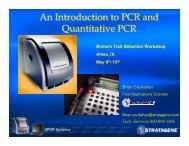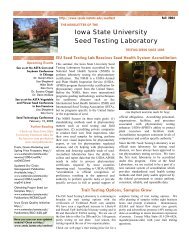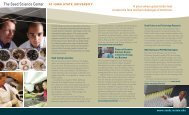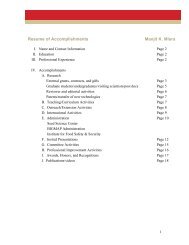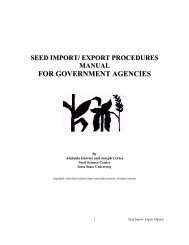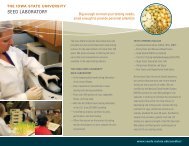Confined Production Processes for Non-Food Corn - Seed Science ...
Confined Production Processes for Non-Food Corn - Seed Science ...
Confined Production Processes for Non-Food Corn - Seed Science ...
Create successful ePaper yourself
Turn your PDF publications into a flip-book with our unique Google optimized e-Paper software.
approval be<strong>for</strong>e initiation; 2) those that require NIH/Officeof Biotechnology Activities and Institutional BiosafetyCommittee approval be<strong>for</strong>e initiation; 3) those thatrequire Institutional Biosafety Committee andInstitutional Review Board approval and RAC reviewbe<strong>for</strong>e research participant enrollment; 4) those thatrequire Institutional Biosafety Committee approvalbe<strong>for</strong>e initiation; 5) those that require InstitutionalBiosafety Committee notification simultaneous withinitiation; and 6) those that are exempt from the NIHGuidelines. The NIH rules illustrate that oversightof PMPs and PMIs should vary depending on theassociated risk.In the NIH regulations, organisms are classified into riskgroups based on the hazard that they present. Biosafetylevel containment levels correspond to the risk groups.Biosafety level 4 provides the most stringent containmentconditions and biosafety level 1 the least stringent. Forexample, conventional greenhouses (with the possibleaddition of screening and impervious floors) are sufficientas level 1 containment, where recipient species that donot interbreed with weeds are used in combination withdonor species that are not exotic infections agents. Arecipient plant that intercrosses with weeds or a donorthat is an entire exotic infectious agent might requirelevel 2 greenhouses with locks, 30 mesh screen,impervious floors, collection of runoff water, andan autoclave.The NIH biosafety levels depend on the level of hazardand implicitly incorporate the principle that risk is theproduct of the hazard level with the probability ofoccurrence. To maintain a given tolerance <strong>for</strong> risk, theconditions of containment must ensure a lower probabilityof exposure if the level of hazard is higher. Conversely,where hazard is low, the degree of stringency inconfinement need not be as high. Risk managementprocedures within organizations involved in PMPs andPMIs could establish hierarchies of risk and biosafetyconfinement level that would be equivalent to thoseestablished by the NIH.The relevant containment programs can be divided intofour categories: 1) a set of standard practices that aregenerally used in microbiological laboratories; 2) speciallaboratory procedures, equipment, and installations thatprovide physical barriers that are applied in varyingdegrees according to the estimated biohazard while plantsare in culture and in the laboratory; 3) special greenhouseprocedures, equipment, and installations adapted <strong>for</strong> largeplants; and 4) biological containment measures that limitthe impact of any unplanned exposure.The following is from http://grants.nih.gov/grants/guide/notice-files/NOT-OD-02-052.html (accessed June 9, 2004):Some recombinant DNA requirements requireapproval in advance of initiation of the experiment. Insome instances, approval must be secured from theinstitutional biosafety committee (IBC), and, in others,from the IBC and the Recombinant DNA AdvisoryCommittee of NIH (RAC).Notification to either body must include:a) the source(s) of DNA;b) the nature of the inserted DNA sequences;c) the hosts and vectors to be used;d) a statement of whether a deliberate attempt willbe made to obtain expression of a <strong>for</strong>eign gene;e) containment conditions specified in the Guidelinesthemselves.Four categories of experiments are exempt from the reviewand approval requirements:a) those that are not in organisms or viruses;b) those that consist entirely of DNA segments froma single nonchromosomal or viral DNA source;c) those that consist entirely of DNA from a prokaryotichost, including its indigenous plasmids or viruseswhen propagated only in that host or whentransferred to another host by well establishedphysiological means; andd) certain specified recombinant DNA moleculesthat consist entirely of DNA segments fromdifferent species that exchange DNA by knownphysiological mechanisms.Minimum Compliance Action: Establish a five-personcommittee charged with the requirements to reviewall research involving the use of recombinant DNAmolecules.The NIH guidelines have been widely copied worldwideas the primary model <strong>for</strong> regulation of physicallyconfined research.A fully indexed, hyperlinked copy of the NIH Guidelinescan be viewed on line or downloaded athttp://www4.od.nih.gov/oba/rac/guidelines/guidelines.html.Laboratory and Greenhouse <strong>Processes</strong> 15



